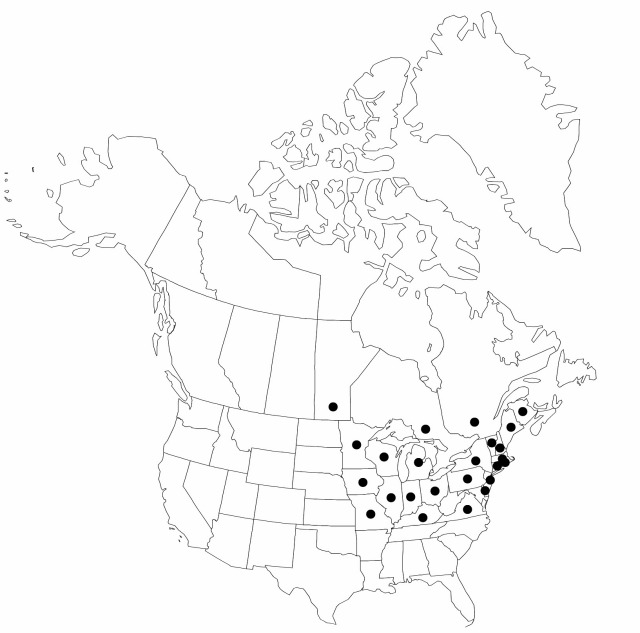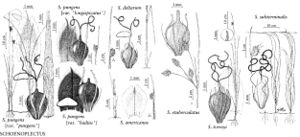Schoenoplectus torreyi
Allg. Bot. Z. Syst. 17(Beil.): 3. 1912.
Plants mat-forming; rhizomes 1–3 mm diam. Culms sharply trigonous, sides concave distally, 0.4–1.5 m × 1.5–5 mm. Leaves 4–7, nearly equaling culm; sheath fronts delicately pinnate-fibrillose; blades 3–6, erect, the distal mostly longer than sheath, 1–2 mm, wide, proximally thickly V-shaped central region trigonous-channeled to laterally flattened, apically asymmetically laterally flattened-trigonous; apex often markedly eccentric, glabrous, smooth or angles papillose. Inflorescences capitate or 1 spikelet; proximal bract erect, resembling leaf-blade, 3–20 cm. Spikelets 1–4, 7–18 × 3–5 mm; scales straw-colored to orangebrown or central region greenish, ovatelanceolate, 4–5 × 2.5 mm, margins entire, smooth or awn sparsely spinulose, sometimes distally ciliolate at 40X, apex acute, mucronate, mucro 0.2–0.5 mm. Flowers: perianth members 6, brown, bristlelike, equaling to slightly exceeding achene, spinulose; anthers 2–3 mm; styles 3-fid. Achenes brown, compressed trigonous, ovoid to obovoid, 3.5–4.5 × 1.7–2 mm; beak 0.5–1 mm. 2n = 70.
Phenology: Fruiting summer.
Habitat: Emergent in fresh ponds and marshes, often with fluctuating water levels
Elevation: 10–200 m
Distribution

Man., N.B., Ont., Que., Conn., Del., Ill., Ind., Iowa, Ky., Maine, Mass., Mich., Minn., Mo., N.H., N.J., N.Y., Ohio, Pa., R.I., Vt., Va., Wis.
Discussion
Schoenoplectus torreyi is very locally distributed, and probably has been extirpated from many historic localities. A specimen from an uncertain locality in Kentucky was collected in 1830. I have not seen specimens from North Dakota, South Dakota, or Nebraska. Scirpus torreyi was placed in synonymy under S. subterminalis Torrey var. cylindricus (Torrey) T. Koyama [misapplied, = Bolboschoenus novae-angliae by T. Koyama (1962b)].
Selected References
None.
Lower Taxa
"shortened" is not a number."prolonged" is not a number.
